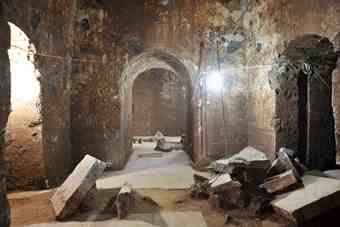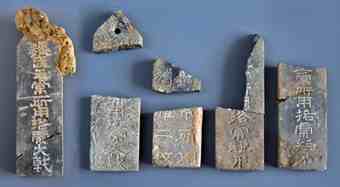Artificial planning and fake artifacts were part of the discovery and excavation of a supposed ancient tomb claiming to belong to Cao Cao, a warlord in the Three Kingdoms period (220-280), a group of experts and scholars announced over the weekend.
 The discovery and excavation of the tomb was listed as a Top Ten Archaeology Achievement in 2009 by the State Administration of Cultural Heritage.
The discovery and excavation of the tomb was listed as a Top Ten Archaeology Achievement in 2009 by the State Administration of Cultural Heritage.
A total of 23 experts and scholars from across the country presented evidence at the National High-Level Forum on Culture of the Three Kingdoms Period held in Suzhou, Jiangsu Province, to prove that the tomb was a fake.
According to epigrapher Li Luping, director of the Committee of Calligraphy and Appraisal of Jiangsu Province, the epitaph of Lu Qian, which directly indicates the specific location of the tomb of Cao Cao, is the source of the forgery.
Li discovered that the character 年 (year) on the epitaph was written in almost the same style as is in modern times, quite different to the more square style in use at the time in history.
 "After over thousands of years of erosion, how come there is residue of the cave on the stone steles from Cao Cao's tomb?" Li said. "Such a cheap counterfeit takes at most three years, if not three days."
"After over thousands of years of erosion, how come there is residue of the cave on the stone steles from Cao Cao's tomb?" Li said. "Such a cheap counterfeit takes at most three years, if not three days."
Lin Kuicheng, director of the Calligraphy and Painting Committee of Kaifeng Federation of Literature and Art Circle, Henan Province, said that the title Wei Wu King carved on the stele of Cao Cao's supposed tomb was not accurate or appropriate.
"Wei King was his title when he was alive and Wu King is his title after his death," Lin explained. "Under ancient customs, there is no way the two titles would have been permitted to be put together."
Zhang Guo'an, an expert on the Wei Jin period (220-420) from Beijing Normal University, said that by studying the changes in the forms and systems of ancient tombs, he found that the newly-unearthed tomb was the same scale as the tomb of Cao Xiu, one of Cao Cao sons, which is very unlikely as the tombs of a father and son would not be the same.
The ancient tomb complex was unearthed in December. It included three ancient corpses, one man and two women. The man died in his 60s, the same age as Cao Cao when he died.
Author: Jiang Wanjuan | Source: Global Times [August 23, 2010]





